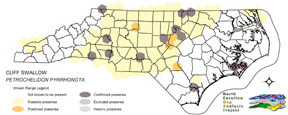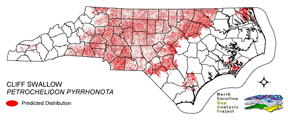
| Taxa: |
| Order: |
| Family: |
| Aves |
| Passeriformes |
| Hirundinidae |
| NatureServe Global Rank: |
| NatureServe State (NC) Rank: |
| G5 |
| S3B,SZN |
| Federal Status: |
| NC State Status: |
| --- |
| --- |


| Land Unit |
| US Fish & Wildlife Service |
| US Forest Service |
| US National Park Service |
| US Department of Defense |
| NC State Parks |
| NC University System |
| NC Wildlife Res. Com. |
| NC Forest Service |
| NC Div. of Coastal Mgmt. |
| Local Governments |
| Non-Governmental Org. |
| Other Public Lands |
| Private Lands |
| GAP Status 1-2 |
| All Protected Lands |
| Statewide |
| Hectares |
| 7,030.44 |
| 3,740.22 |
| 14,589.18 |
| 7,808.22 |
| 1,885.05 |
| 144.36 |
| 5,433.30 |
| 107.55 |
| 581.94 |
| 1,174.50 |
| 2,203.11 |
| 472.14 |
| 2,443,979.88 |
| 21,277.98 |
| 42,569.82 |
| 2,489,149.89 |
| Acres |
| 17,372.59 |
| 9,242.28 |
| 36,050.64 |
| 19,294.53 |
| 4,658.06 |
| 356.72 |
| 13,425.97 |
| 265.76 |
| 1,438.00 |
| 2,902.25 |
| 5,444.00 |
| 1,166.68 |
| 6,039,204.63 |
| 52,579.02 |
| 105,192.30 |
| 6,150,822.13 |
| % of Dist. on |
| Prot. Lands |
| 16.5 % |
| 8.8 % |
| 29.4 % |
| 18.3 % |
| 4.4 % |
| 0.3 % |
| 12.6 % |
| 0.3 % |
| 1.4 % |
| 5.0 % |
| 5.0 % |
| 0.2 % |
| 0.0 % |
| 50.0 % |
| ----- |
| ----- |
| % of Dist. on |
| All Lands |
| 0.3 % |
| 0.2 % |
| 0.6 % |
| 0.3 % |
| < 0.1 % |
| < 0.1 % |
| 0.2 % |
| < 0.1 % |
| < 0.1 % |
| < 0.1 % |
| < 0.1 % |
| < 0.1 % |
| 98.2 % |
| 0.9 % |
| ----- |
| ----- |
|
Breeds locally at a few sites in the mountains (Simpson 1992) and piedmont (Potter et al. 1980). Found in a variety of open and semi-open habitats, especially near water, where there is sufficient mud for nesting material and suitable surfaces for nest sites. Nests colonially, primarily on the sides of buildings (Kaufman 1996), dams, bridges, and other man- made structures, but also in its ancestral habitat of cave mouths and cliffs (Nicholson 1997). Builds a mud nest shaped like a gourd (Nicholson 1997). Forages on the wing, often over water, and often in flocks. Will also forage on the ground, especially in bad weather (Kaufman 1996). NATURE SERVE GLOBAL HABITAT COMMENTS: Open to semiwooded habitat, cliffs, canyons, farms; near meadows, marshes, and water. Builds bottle shaped mud nest in colonies on cliffs, eaves of buildings, under bridges, etc. Prefers sites with overhang. Use of natural sites is greatest in the west. Many return to same nesting area in successive years, but colonies tend to switch nesting sites between season, evidently due to a buildup of insect parasites in the nests. Commonly repairs and uses old nests. |
| Code | Name | Description | NC Natural Heritage Program Equivalent |
| 378 | Ocean Beaches | Open beach sand. | Upper Beach |
| 3 | Tidal Marsh | Fresh and brackish tidal marshes, including cord grass, wild rice, sawgrass and needlerush alliances. | Brackish Marsh, Interdune pond, Maritime wet grassland |
| 124 | Maritime Scrubs and Tidal Shrublands | Coastal shrubs including wax-myrtle, swamp rose, alder, yaupon, and greenbriar. | Maritime Shrubs, Salt Shrub |
| 375 | Hypersaline coastal salt flats | Tidal flats within salt marshes, including saltmeadow cordgrass or sea-purslane dominated alliances. | Salt Marsh |
| 372 | Interdune Herbaceous Wetlands | Dune swales with permanently flooded to intermittently exposed hydrology. Species composition depends on salinity and can include cut grass, spike-rush, mosquito fern, and hornwort. | Interdune Pond, Maritime Wet Grasslands |
| 371 | Maritime Grasslands | Dune grass community consisting of sea oats and beach grasses. | Dune grass, Maritime dry grassland |
| 380 | Coastal Plain Fresh Water Emergent | Emergent vegetation in fresh water seepage bogs, ponds and riverbeds of the coastal plain. Includes alliances dominated by sedges, eelgrass, as well as cane found in unforested cane-brakes. | Small Depression Pond, Sandhill Seep, Floodplain Pool, Unforested Floodplain Canebrake, Riverscour Prairies, Vernal Pools |
| 173 | Coastal Plain Riverbank Shrubs | Shrub dominated riverbanks, commonly dominated by willows and/or alders. | Sand and Mud Bar |
| 78 | Pond-Cypress - Gum Swamps, Savannas and Lakeshores | Cypress dominated swamps and lakeshores. Can include bays dominated by pond cypress or shorelines of coastal plain lakes with a narrow band of cypress. | Non-riverine Swamp Forest, Natural Lakeshores (in part) |
| 238 | Piedmont/Mountain Submerged Aquatic Vegetation | Seasonally to permanently flooded areas with aquatic vegetation. Waterlily, pondweed, hydrilla smartweed are a few of the species that can occur. | Piedmont/Mountain Semipermanent Impoundment (in part) |
| 239 | Piedmont/Mountain Emergent Vegetation | Emergent vegetation of all wetland hydrologies. Sites would commonly support species such as tussock sedge, rushs, and cattail alliances. | Rocky Bar and Shore (in part) |
| 267 | Riverbank Shrublands | Riverside shrubs with temporarily flooded hydrologies. Found in the both the Mountains and Piedmont. Containing dominants such as smooth alder and a Carolina or black willows. | Sand and Mud Bar |
| 269 | Floodplain Wet Shrublands | Saturated shrublands of the Piedmont, includes buttonbush, swamp-loosestrife, decodon and alders. | Piedmont/mountain Semipermanent Impoundment |
| 20 | Coniferous Regeneration | Regenerating pine stands. Predominantly loblolly pine, but slash and longleaf stands occur as well. | No equivalent |
| 36 | Successional Deciduous Forests | Regenerating deciduous trees with a shrub stature. Commonly dominated by sweetgum, tulip poplars and maples. | No equivalent |
| 180 | Agricultural Crop Fields | Farm fields used for row crops. | No equivalent |
| 205 | Agricultural Pasture/Hay and Natural Herbaceous | Farm fields used for pasture grass or hay production, as well as old fields dominated by native and exotic grasses. | No equivalent |
| 213 | Barren; quarries, strip mines, and gravel pits | Quarries, strip mines, or gravel pits. | No equivalent |
| 214 | Barren; bare rock and sand | Areas of bare rock, sand or clay. | No equivalent |
| 202 | Residential Urban | Includes vegetation interspersed in residential areas. Includes lawns, mixed species woodlots, and horticultural shrubs. Vegetation accounts for between 20 - 70% of the cover. | No equivalent |
| 203 | Urban Low-Intensity Developed | Highly developed areas with vegetation accounting for < 20% of the cover. | No equivalent |
| 8 | Open water | Open water without aquatic vegetation. | No equivalent |
| 534 | Appalachian Wet Shrubland/ Herbaceous | Saturated shrubs and herbaceous vegetation. Often mapped as an inclusion in Appalachian Swamp Forest. | Southern Appalachian Bog, Southern Appalachian Fen |
|
Sheldon, F. H., and D. W. Winkler. 1993. Intergeneric phylogenetic relationships of swallows estimated by DNA-DNA hybridization. Auk 110:798-824.
Banks, R. C., and M. R. Browning. 1995. Comments on the status of revived old names for some North American birds. Auk 112:633-648. Ehrlich, P.R., D.S. Dobkin, and D. Wheye. 1992. Birds in jeopardy:the imperiled and extinct birds of the United States and Canada, including Hawaii and Puerto Rico. Stanford University Press, Stanford, California. 259 pp. Hagan, J.M., III, and D.W. Johnston, editors. 1992. Ecology and conservation of neotropical migrant landbirds. Smithsonian Institution Press, Washington, D.C. xiii + 609 pp. Simpson MB Jr. 1992. Birds of the Blue Ridge Mountains. Chapel Hill and London: University of North Carolina Press. Sauer, J.R., and S. Droege. 1992. Geographical patterns in population trends of neotropical migrants in North America. Pages 26-42 in J.M. Hagan III and D.W. Johnston, editors. Ecology and conservation of neotropical migrant landbirds. Smithsonian Institu Silver, M. 1995. Conservation of cliff swallows in Massachusetts. Bird Observer 23(6):327-332. Kaufman K. 1996. Lives of North American Birds. Boston, New York: Houghton Mifflin Company. Nicholson CP. 1997. Atlas of the breeding birds of Tennessee. Knoxville: University of Tennessee Press. Bureau of Land Management. Life History Summaries. Harrison, C. 1978. A field guide to the nests, eggs and nestlings of North American birds. Collins, Cleveland, Ohio. Potter, E. F., J. F. Parnell, and R. P. Teulings. 1980. Birds of the Carolinas. Univ. North Carolina Press, Chapel Hill. 408 pp. Terres, J.K. 1980. The Audubon Society encyclopedia of North American birds. Alfred A. Knopf, New York. American Ornithologists' Union (AOU), Committee on Classification and Nomenclature. 1983. Check-list of North American Birds. Sixth Edition. American Ornithologists' Union, Allen Press, Inc., Lawrence, Kansas. Raffaele, H.A. 1983. A guide to the birds of Puerto Rico and the Virgin Islands. Fondo Educativo Interamericano, San Juan, Puerto Rico. 255 pp. Krapu, G. L. 1986. Patterns and causes of change in a cliff swallow colony during a 17-year period. Prairie Nat. 18:109-114. Hilty, S.L., and W.L. Brown. 1986. A guide to the birds of Colombia. Princeton University Press, Princeton, New Jersey. 836 pp. Phillips, A.R. 1986. The known birds of North and Middle America:distribution and variations, migrations, changes, hybrids, etc. Part I, Hirundinidae to Mimidae, Certhiidae. Published by the author, Denver, Colorado. lxi + 259 pp. Byrd, M.A., and D.W. Johnston. 1991. Birds. Pages 477-537 in K. Terwilliger, coordinator. Virginia's endangered species:proceedings of a symposium. McDonald and Woodward Publ. Co., Blacksburg, Virginia. Ridgely, R.S., and G. Tudor. 1989. The birds of South America. Vol. 1. The Oscine passerines. Univ. Texas Press, Austin. 516 pp. Stiles, F.G., and A.F. Skutch. 1989. A guide to the birds of Costa Rica. Comstock Publ. Associates, Cornell University Press, Ithaca, New York. 511 pp. Turner, A., and C. Rose. 1989. Swallows and martins an identification guide. Houghton Mifflin Co., Boston. Brown, C. R., and M. B. Brown. 1988. The costs and benefits of egg destruction by conspecifics in colonial cliff swallows. Auk 105:737-748. |
For more information please contact them at:
NC-GAP Analysis Project
Dept. of Zoology, NCSU
Campus Box 7617
Raleigh, NC 27695-7617
(919) 513-2853
www.basic.ncsu.edu/ncgap